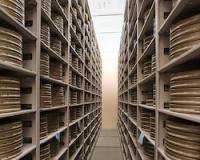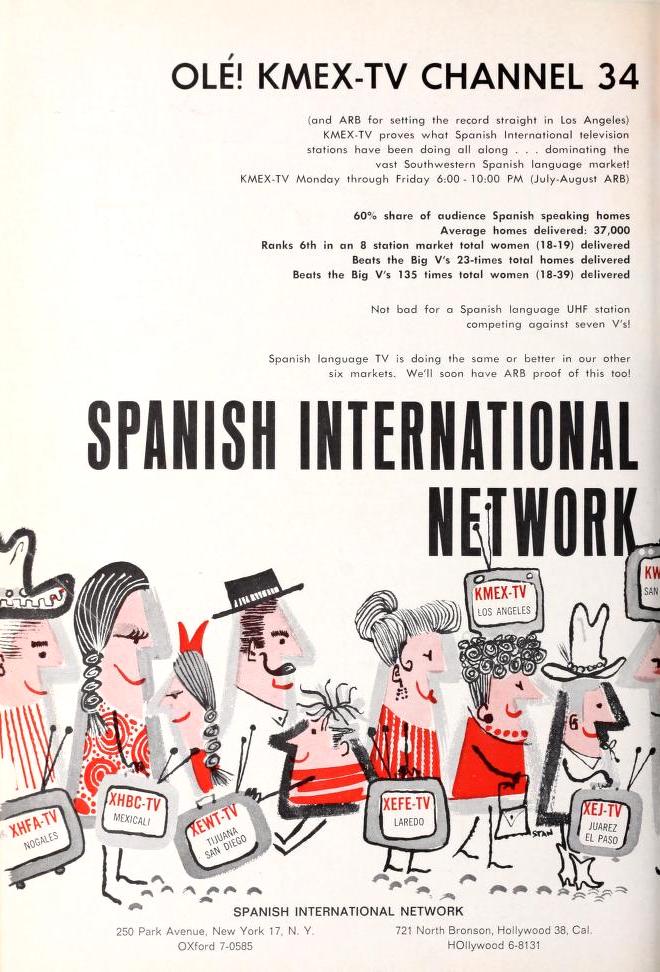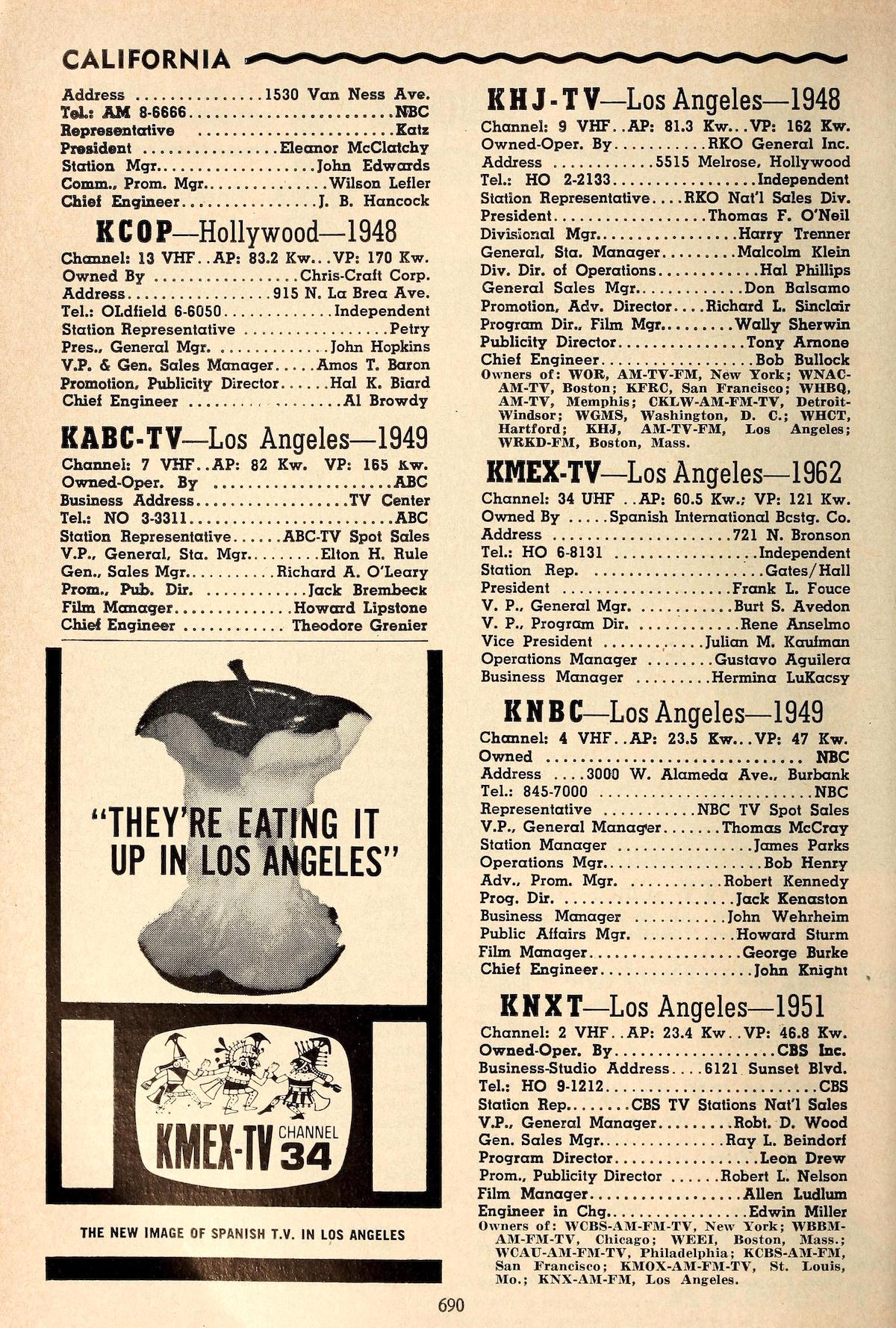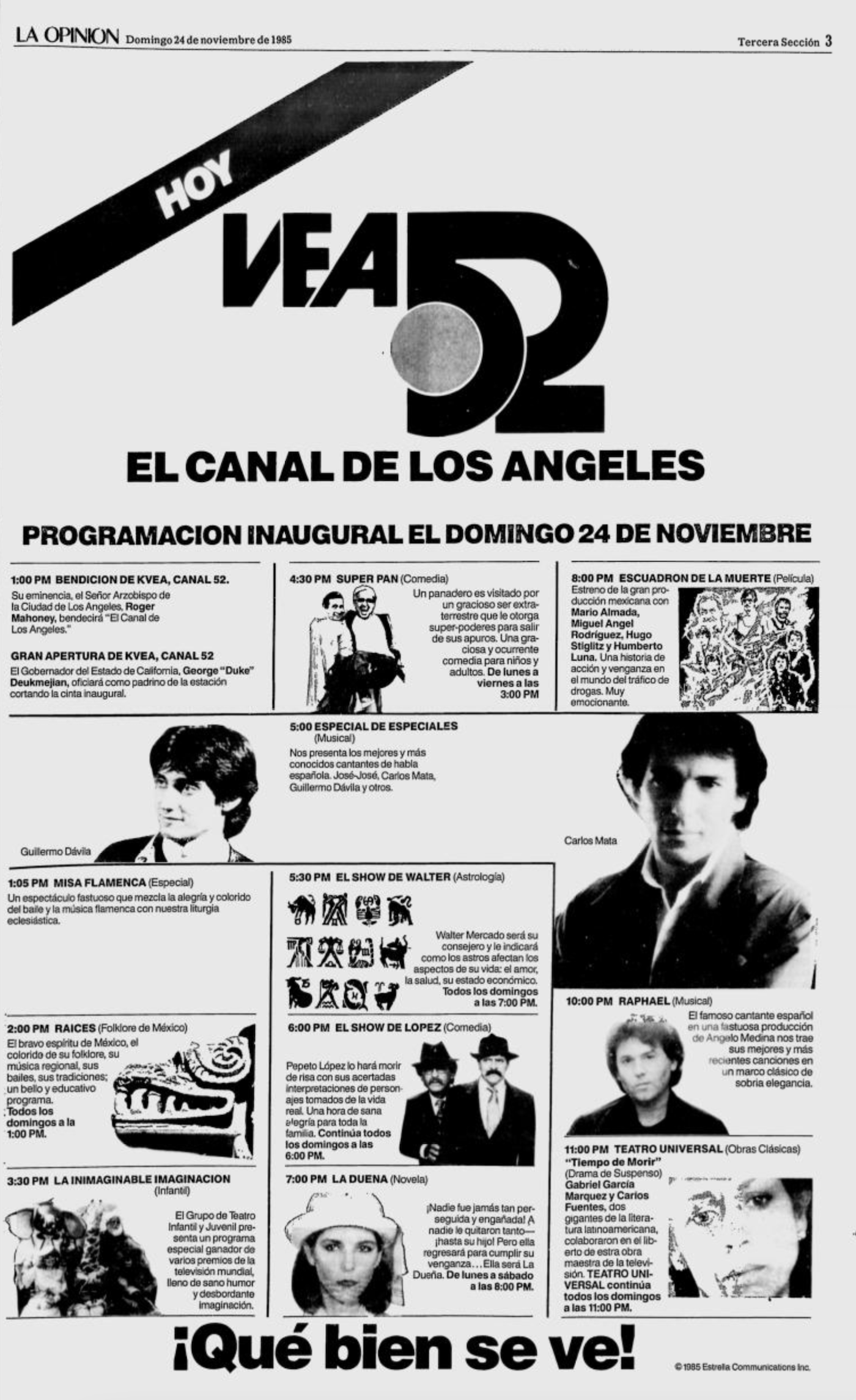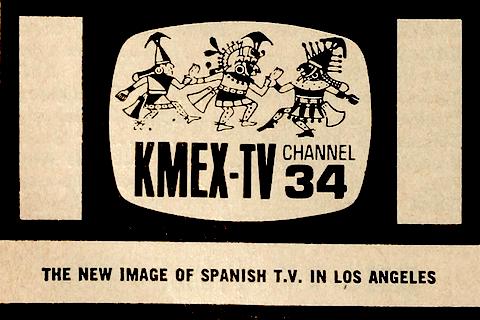
Advertisement for KMEX-TV, 1963
Our guest writer is Carlos Francisco Parra, a Fellow in the University of Arizona’s inaugural President’s Postdoctoral Fellowship Program, where he is currently writing a book on the cultural history of Spanish-language television in Los Angeles. Previously he earned his Ph.D. in history from the University of Southern California and served as a Visiting Assistant Professor of Chicana/o-Latina/o Studies at Loyola Marymount University in Los Angeles. This blog was made possible by the Myra Reinhard Family Foundation.
Television is one of the biggest mass media presences in our modern cultural life, but the medium’s dissemination as broadcast signals also gives TV programs, particularly locally produced programming, an ephemeral quality. Unlike newspapers and magazines, which can survive in the form of physical copies in archival repositories, locally produced programming is often aired only once. As cultural artifacts of a specific time and place, locally produced TV programming can serve as a valuable window into understanding our cultural history. However, accessing surviving footage of historical TV programming is a challenging task, particularly the further back one goes into the 20th century. The UCLA Film & Television Archive’s television news holdings in its general collection, and the Archive’s News and Public Affairs (NAPA) Collection—a broad resource that consists of over 100,000 news programs taped off air of primarily English-language local and network news stations from 1979-2003—have been a foundational resource for my book project on the cultural history of Spanish-language TV in Latino Southern California.
Spanish-language television stations Univision KMEX Channel 34 and Telemundo KVEA Channel 52 debuted in the Los Angeles area in 1962 and 1985, respectively, and laid the groundwork for the national U.S. Spanish-language TV industry. Indeed, the U.S.’ largest concentration of Latinos (and consequently its largest Latino media market) has been metropolitan Los Angeles. Though instrumental in making their respective networks reach national audiences, KMEX and KVEA were ultimately local stations at heart and unequipped to archive their accumulating recording library U-Matic, Beta, and VHS tapes.
Left: KMEX-TV advertisement in Sponsor magazine, October 19, 1964. Source: Media History Digital Library.
Right: KMEX-TV advertisement and directory in The Radio Annual and Television Year Book, 1963. Source: Media History Digital Library.
The UCLA Film & Television Archive’s (FTVA) television collection possesses two digitized kinescopes of KMEX-34 programming from the 1960s as well as Beta and VHS recordings of nightly KMEX and KVEA newscasts from the 1980s onwards, making it possible to study how Spanish-language TV in Los Angeles articulated ideas of ethnicity, citizenship, and cultural unity among Latinos. The NAPA Collection recordings include full programs along with their accompanying commercials, enabling researchers to evaluate TV broadcasts in their full context. In many cases, FTVA’s general television collection and its NAPA Collection serve as the only repositories for surviving copies of certain shows that aired on KMEX and KVEA.
Examples of this are surviving recordings of 1960s sports programming on KMEX-34. Although in October 1962 L.A. Times reviewer Pepe Arciga dismissed televised boxing on Channel 34 as fare “strictly for those resigned to follow boxing to its grave” due to the blurry image quality of the taped matches, KMEX broadcasts of local and Mexico-based boxing matches drew in scores of viewers hankering for a regular schedule of fights. Daniel Villanueva, a former L.A. Rams kicker (and KMEX’s longtime general manager from 1971-1989), gained wide fame as a Spanish-language TV personality from his role as a boxing sportscaster. The archived kinescopes of matches such as the May 7, 1965 fight between defending featherweight world boxing champion Vicente “El Zurdo de Oro” Saldívar of Mexico City and Raul Reyes of San Pedro, California, at the Los Angeles Memorial Coliseum are crucial in enabling scholars to retrace Spanish TV’s cultural influence on Latino Southern California through sports.
Left: La Opinión newspaper advertising the inaugural programs of KVEA-52 on November 24, 1975. Source: Google News Archive.
Right: KMEX-TV advertisement in The Hollywood Reporter, March 13, 1984.
However, news-related programming makes up the bulk of resources in the NAPA Collection, such as Telemundo KVEA-52’s Cara a Cara (Face to Face) talk show, which debuted in 1987. Preceding Univision’s more famous El Show de Cristina hosted by Cristina Saralegui, Cara a Cara introduced the daytime talk show format into U.S. Spanish TV and was produced at KVEA-52’s Glendale studios and rebroadcast across Telemundo’s affiliates. The NAPA Collection preserves rare early recordings of Cara a Cara, which enables historians to examine how complex social issues were presented on Spanish-language TV by the late 1980s/early 1990s—a historic moment in which the Latino population of metropolitan Los Angeles underwent massive demographic expansion. Hosted by Cuban American journalist Maria Laria, Cara a Cara’s guests and audience members actively deliberated over concerns about life as racialized ethnic minorities in the United States. For example, the February 24, 1988 Cara a Cara episode featured Cuban-born L.A. resident Ángel Hernández as the main guest in a discussion of the ongoing impact of the 1980 Mariel boatlift, specifically the problems faced by several thousand Mariel refugees still detained years later. Hernández led a prison riot at the U.S. Penitentiary in Atlanta when the U.S. announced it would repatriate them to Cuba. Hernández told Laria many Cuban refugees suffered greatly from white American racism. Hernández quoted the words of U.S. prison guards. “La palabra de ellos típica era ‘You have no rights in this country.’ Ustedes no tienen derechos en este pais.” (“They regularly told us ‘You have no rights in this country. You have no rights in this country.’”) Throughout the episode, panelists and audience members debated whether the U.S. was a true democracy if it could detain political asylum seekers indefinitely without due process. Unscripted moments like these demonstrate U.S. Spanish-language TV’s function as a public sphere for Latinos to articulate their anxieties about life in U.S. society. Cara a Cara’s conversation about late Cold War Cuban asylum seekers, one of many such moments preserved through the FTVA’s collections, gives a deeper historical perspective to our modern-day immigration conversations about Central American asylum seekers. Having access to historic programs like Cara a Cara—a show now long-forgotten—is crucial in helping scholars discern larger patterns of U.S. and Latino history.
The ability to view archived broadcasts is an invaluable scholarly resource that enables research into this topic to go beyond impressions of KMEX and KVEA programming documented by critics in trade journals. Indeed, one can better interpret these broadcasts as cultural texts by viewing them in their full context with their hosts, guests, on-air graphics, music, and even accompanying commercial breaks. Given the importance of Univision KMEX and Telemundo KVEA establishing national-level networks through their successful engagement of Latino viewers in Southern California, the UCLA Film & Television Archive offers a valuable front row seat into this rich history.
Learn how to make a research viewing appointment at the Archive Research and Study Center.






 Mobile Navigation
Mobile Navigation
